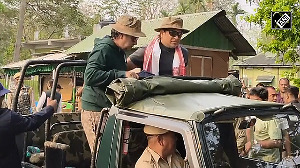 China has been keeping tabs on the restive Tibet province through a ‘grid’ system and some 600 ‘convenience police posts' armed with high-tech equipment that monitor the daily life of the citizens of Lhasa and other Tibetan towns. Worse, ‘volunteer security groups’ known as 'Red Armband Patrols' are roaming around in order to get more information and ‘classify’ each and every citizen, says Claude Arpi
China has been keeping tabs on the restive Tibet province through a ‘grid’ system and some 600 ‘convenience police posts' armed with high-tech equipment that monitor the daily life of the citizens of Lhasa and other Tibetan towns. Worse, ‘volunteer security groups’ known as 'Red Armband Patrols' are roaming around in order to get more information and ‘classify’ each and every citizen, says Claude Arpi
When Chinese President Xi Jinping met his American counterpart at Sunnylands, a luxurious desert estate in southern California, Xi denied that there was any wrongdoing from China’s side, and Beijing was not spying on the United States. The cyber security issue needed to be resolved in a ‘pragmatic way’, said Xi.
A few hours earlier, the Guardian, quoting from a top secret document, reported that the US National Security Agency had been using a programme called PRISM, which allows US officials to collect personal information including search history, content of emails, file transfers and live chats from various American companies such as Google, Facebook or Apple.
Suddenly, it was the pot calling the kettle black. Or was it?
Not really. China is still far 'in advance' of the US in citizens’ surveillance. Take Tibet’s example.
Already in March, Human Rights Watch noticed that a new system had been put in place in Tibet to watch the 'masses'. The HRW report, ‘China: Alarming New Surveillance, Security in Tibet -- Restrictions Tightened on Tibetans Despite Lack of Threat’ described a dreadful 'grid' system to monitor the recalcitrant Tibetans.
Sophie Richardson, HRW’s China director said: ‘Chinese authorities should dismantle this Orwellian ‘grid’ system, which has been imposed while the government continues to avoid addressing popular grievances. Its purpose appears to be surveillance and control, and it encroaches on Tibetans’ rights to freedom of expression, belief, and association.’
The US-based human rights organisation goes into detail about the infamous 'grid'. Though officially the 'grid management’ system is designed to improve public access to basic services, it dramatically increases surveillance and monitoring. Dividing big cities into ‘grids’, it particularly targets 'special groups' such as former prisoners, returnees from exile in India, and monks. The smallest clusters of the grid are composed of a few households only, with a Party cadre watching.
Apart from the grid system, Big Brother installed some 600 ‘convenience police posts' with high-tech equipment to monitor the daily life of the citizens of Lhasa and other Tibetan towns. Worse, ‘volunteer security groups’ known as 'Red Armband Patrols' are roaming around in order to get more information and ‘classify’ each and every citizen.
Are these 'Red Armband Patrols' not reminiscent of the Great Proletarian Cultural Revolution and its millions of victims?
What greatly surprises me is the return of the Cultural Revolution's methods under Xi Jinping who suffered a lot from Mao's follies when his father Xi Zhongxun was purged in September 1962.
Does the new president endorse these practices, or is the Shanghai Gang, lead by former President Jiang Zemin, still controlling the Tibet affairs through the Central Working Coordination Small Group on Tibet?
This all-powerful Small Group under Yu Zhengsheng, the chairman of the Chinese People's Political Consultative Conference, is today responsible for ethnic and minorities affairs. Yu, let us not forget, was Shanghai Party’s boss before being elevated to no. 4 in the Party.
In January 2010, the 5th Tibet Work Forum was held in Beijing. Tibet Work Forums are large meetings of 200 or 300 cadres, called every five or 10 years to discuss the Communist Party’s Tibet policies. They are attended by all members of the powerful Politburo's Standing Committee, senior PLA generals, United Front Work Department officials, regional leaders, etc.
Though extremely secretive, it appears that the last Forum showed the way to the Party officials on how best to 'benefit the masses' and at the same time, avoid the recurrence of the 2008 unrest on the Roof of the World.
The Small Group on Tibet which is responsible for implementing the Tibet Work Forum’s decisions probably met a few times to work out the modalities of the scheme ‘benefitting the masses’.
Since March, further 'progresses' have been made in the repressive system.
President Obama may be right when he termed the US surveillance a ‘modest encroachment on privacy’. Indeed it is 'modest' compared to the Chinese 'grid' surveillance on the Roof of the World.
On June 20, Xinhua reported that ‘as required by a 2011 local regulation’, all Internet, fixed line and mobile phone users in the Tibet Autonomous Region have provided service operators with their real names.
The Chinese official news agency says: ‘By the end of 2012, 2.76 million fixed line and mobile phone users and 1.47 million web users in Tibet had registered for services under their real identities, according to data from the regional communications administration.’
Xinhua defends these drastic measures (which mean that from now on the Tibetans' phone conversations or email exchanges will be monitored): ‘The real-name registration is conducive to protecting citizens' personal information and curbing the spread of detrimental information’, said one local government official.
Dai Jianguo, a member of Tibet’s Political and Legal Affairs Commission explained: ‘The growing popularity of the Internet and mobile phones has brought about social problems, including the rampant circulation of online rumors, pornography and spam messages.’
But monitoring Lhasa and the large cities was not enough; in 2011, China decided to also target the countryside.
Another HRW report gives frightening details about the scheme which has been 'working' for the past 18 months. The title of the HRW report is 'China, Benefiting the Masses, Campaign Surveilling Tibetans'. Like the phone tapping or the 'grid' surveillance, the countryside monitoring will ultimately be for the benefit of the masses, says Beijing.
Sophie Richardson explained: ‘It’s hard to see the ‘benefit’ to Tibetans of thousands of political education sessions, partisan quasi-police force operations, and scrutiny of their political views. In a region where people are already subjected to extraordinary monitoring, this village-level drive, alongside similar efforts directed at towns and monasteries, effectively means that Tibetans cannot avoid state surveillance.’
What is the new scheme?
Under the pretext of improving rural living standards, Beijing has sent some 20,000 officials and Communist Party cadres to more than 5,000 Tibetan villages ‘to undertake intrusive surveillance of people, carry out widespread political re-education, and establish partisan security units. …These tactics discriminate against those perceived as potentially disloyal, and restrict their freedom of religion and opinion,’ says HRW.
When on October 10, 2011, the three-year scheme was launched in the Tibetan Autonomous Region, it was described by the Chinese media as ‘necessary for improving living conditions and prosperity for people living in rural areas.’
After the 2008 Tibetan Spring, the Chinese authorities constantly feared ‘splittist sabotage by hostile forces and the Dalai Clique.’
In February 2013, Yu Zhengsheng said that forces supporting the Dalai Lama should be ‘resolutely ground into dust’. He also spoke of ‘Nets in the sky and traps on the ground’ as the policy to be followed in Tibet.
The benefitting the masses’ scheme has five objectives: the two first are to expand the role and size of the Party in the countryside and to ‘maintain stability by carrying out activities against the Dalai clique.’
People are classified into three categories: ‘Those who want wealth and support the current system; those who secretly pray to and support the Dalai Lama but do not protest openly; and those who do not accept re-education and do not have faith in motherland and party.’
The last group is specially targeted.
On February 28, 2013, Hao Peng, then the Party’s Deputy Secretary of the TAR declared that the paramilitary forces must ‘thoroughly ensure [that there are] no shadows, no gaps, no cracks, not giving hostile forces even the slightest opportunity’ in Tibet.
Since then, Hao has been promoted Governor of Qinghai’s province.
It is a campaign unprecedented in its scope, size, and cost, says HRW: ‘Some 21,000 cadres -- the largest proportion of a provincial-level cadre force -- have been sent to the countryside.’ They have been stationed in groups of four or more in each of the 5,451 villages in the TAR for three years.
The budget is colossal, but China is rich!
Interestingly, a serious incident happened in the Nagchu prefecture on May 24. Over 1,000 vehicles loaded some 5,000 Tibetans from the four major nearby areas of Pekar, Nagshoe Phudha and Tsala gathered in Dathang town, near a sacred mountain. They were protesting against Chinese mining in the county. Chen Quanguo, Tibet’s Party chief had just come to the area for an ‘inspection tour’. During a Tibet Small Group meeting in Beijing, Yu Zhengsheng would have given Chen a message to carry: it said, ‘Bring stability and harmony to Nagchu’.
The Nagchu incident was the largest since 2008 on the Roof of the World.
It is clear that the reinforced ‘Orwellian’ surveillance has not managed to dampen the spirit of the masses.
Image: A morning ritual at the Dzamthang monastery in Tibet. Photograph: Kim Kyung-Hoon/Reuters









 © 2025
© 2025